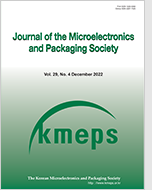
Search
- Past Issues
- e-Submission
-

KCI Accredited Journals KCI 등재지
KCI Impact Factor 0.54
Editorial Office
- +82-2-538-0962
- +82-2-538-0963
- kmeps@kmeps.or.kr
- http://kmeps.or.kr/

KCI Accredited Journals KCI 등재지
KCI Impact Factor 0.54
Journal of the Microelectronics and Packaging Society 2024;31(3):1-9. Published online: Oct, 29, 2024
DOI : doi.org/10.6117/kmeps.2024.31.3.001
This paper addresses the significance of Cu/Polymer Hybrid Bonding technology in the advancement of semiconductor packaging. As the demands of the AI era increase, the semiconductor industry is exploring heterogeneous integration packaging technologies to achieve high I/O counts, low power consumption, efficient heat dissipation, multifunctionality, and miniaturization. The conventional Cu/SiO2 Hybrid Bonding structure faces limitations such as achieving compatibility with CMP processes to attain surface roughness below 1nm and the occurrence of bonding defects due to particles. However, Cu/Polymer Hybrid Bonding technology, utilizing polymers, is gaining attention as a promising alternative to overcome these challenges. This study focuses on the deposition, patterning, and material properties of polymers essential for Cu/Polymer Hybrid Bonding, highlighting the advantages and potential applications of this technology compared to existing methods. Specifically, the use of polymers with low glass transition temperatures (Tg) is discussed for their benefits in low-temperature bonding processes and improved mechanical properties due to their high coefficients of thermal expansion. Furthermore, the study explores surface property modifications of polymers and the enhancement of bonding mechanisms through plasma treatment. This research emphasizes that Cu/Polymer Hybrid Bonding technology can serve as a critical breakthrough in developing high-performance, low-power semiconductor devices within the industry.
Keywords 3D IC Package, Hybrid Bonding, Polymer Dielectric, Cu/Polymer Hybrid Bonding